Posts Tagged ‘veterinarians’
Food Allergies In Pets: What You Need To Know
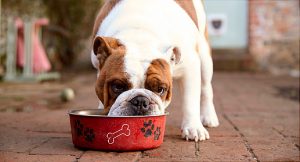 With the onset of spring, many pets are exposed to the outside environment. This has caused them to become more “itchy” and their scratching has caused discomfort to then leaving the owner searching for possible remedies. Unfortunately, their scratching and head shaking may be caused by the diet that they are fed.
With the onset of spring, many pets are exposed to the outside environment. This has caused them to become more “itchy” and their scratching has caused discomfort to then leaving the owner searching for possible remedies. Unfortunately, their scratching and head shaking may be caused by the diet that they are fed.
Many dogs and cats for that matter may suffer from food allergies. These allergies can hit about anytime during their lives and present itself with many different symptoms. These symptoms may range from odorous, greasy, dander-laced hair with chronic ear issues to maybe diarrhea with increased flatulance. Your pet may be constantly chewing on its paws, making them red and keeping you up at night with its chewing and licking. A lot of time, we will try and just mask the signs so that they can remain comfortable without diagnosing the problem. Chances are they inherited the trait from their parents.
When these signs appear, looking for the food that causes the issues may be real difficult in finding and the testing is even more difficult. Common food allergies may consist of beef, pork, chicken, corn, wheat, or a number of other ingredients. Food allergies may include one to many ingredients in the diets, so it is not as cut and dried as it may seem to just switch diets. Also blood testing is of no use in determining the allergies.
So with that said, food ingredient avoidance is the best means of controlling the allergies. So an owner may be instructed to feed a very limited ingredient diet for several weeks and see how the pet responds to the diet. Will the pet be pruritic? Will the pet’s skin be odorous? If the clinical signs are better, then you may be able to add additional ingredients and see how your pet responds.
Some owner’s will prefer to feed raw diets or homemade diets. However, those will sometimes be difficult to balance the ration to get the proper minerals and vitamins. Regardless of what you choose, do not hesitate to contact our office and we can help you navigate this issue. Contact us today.
When And How To Brush Your Dog’s Teeth
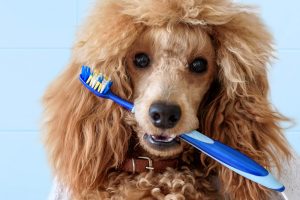 Eighty percent of dogs show signs of gum disease by the time they are two years old. The best cure for these dental issues are early prevention. Once plaque has formed on the teeth, the only way it can be removed is with a mechanical cleaning. Without brushing, this plaque build up can cause gum disease, bad breath, and tooth decay.
Eighty percent of dogs show signs of gum disease by the time they are two years old. The best cure for these dental issues are early prevention. Once plaque has formed on the teeth, the only way it can be removed is with a mechanical cleaning. Without brushing, this plaque build up can cause gum disease, bad breath, and tooth decay.
You can help your dog’s teeth by beginning dental maintenance early. In order to keep your dog comfortable while brushing its teeth, wait until your dog has all of their adult teeth before using a toothbrush. This should be around six months.In order for your dog to get comfortable with a toothbrush, you should start brushing your dog’s teeth as early as possible.
To start brushing your dog’s teeth, begin by gently rubbing your puppy’s gums with your finger. Ease into it by massaging their gums regularly while you are snuggling them. Once they are used to your finger, switch to a soft rubber brush that fits on your fingertip. Only use toothpaste that is specifically made for dogs. This comes in flavors like beef, chicken, banana, and mint. You can find this at your local pet store. Once your dog has their adult teeth, begin a weekly brushing regimen and work your way up to three to four times per week.
To begin brushing your dog’s teeth, make sure that you are in a position where your dog is comfortable. You should try kneeling or sitting in front/side of them in order to not appear threatening. If your dog seems upset, stop and try again later. Prep your toothbrush with doggy toothpaste and use small circular motions. Focus on the plaque. Slight bleeding may occur, but if heavy or ongoing bleeding occurs, stop. This might be a sign of too aggressive brushing or even gum disease. Call your vet for advice. Be sure to be reassuring while brushing your dog’s teeth. Keep the mood light and remind your dog that they are a good boy/girl. End the brushing session with their favorite treat or extra attention.
Other ways to maintain dental wellness is to provide chew toys. Teething is a part of puppy-parenting. Plenty of specially designed puppy toys will be handy in managing this teething. Mildly abrasive foods and toys help keep your dog’s teeth clean. It is important to note that you should avoid natural bones, antlers, dried cow hooves, hard nylon toys, and large rawhide toys with puppies. These are hard enough to fracture delicate puppy teeth.
Lastly, be sure to schedule dental check ups with your vet. Dogs should go to the vet twice a year for a dental exam. They might need their teeth cleaned annual. If you pup’s breath is especially stinky lately, you should call your vet. Bad breath might be a sign of dental problems or even gum disease.
As always, we are here for the health of your pet. Please contact us today if you have any questions.
When And How To Brush Your Dog’s Teeth
 Eighty percent of dogs show signs of gum disease by the time they are two years old. The best cure for these dental issues is early prevention. Once plaque has formed on the teeth, the only way it can be removed is with a mechanical cleaning. Without brushing, this plaque build-up can cause gum disease, bad breath, and tooth decay.
Eighty percent of dogs show signs of gum disease by the time they are two years old. The best cure for these dental issues is early prevention. Once plaque has formed on the teeth, the only way it can be removed is with a mechanical cleaning. Without brushing, this plaque build-up can cause gum disease, bad breath, and tooth decay.
You can help your dog’s teeth by beginning dental maintenance early. In order to keep your dog comfortable while brushing its teeth, wait until your dog has all of their adult teeth before using a toothbrush. This should be around six months. In order for your dog to get comfortable with a toothbrush, you should start brushing your dog’s teeth as early as possible.
To start brushing your dog’s teeth, begin by gently rubbing your puppy’s gums with your finger. Ease into it by massaging their gums regularly while you are snuggling them. Once they are used to your finger, switch to a soft rubber brush that fits on your fingertip. Only use toothpaste that is specifically made for dogs. This comes in flavors like beef, chicken, banana, and mint. You can find this at your local pet store. Once your dog has their adult teeth, begin a weekly brushing regimen and work your way up to three to four times per week.
To begin brushing your dog’s teeth, make sure that you are in a position where your dog is comfortable. You should try kneeling or sitting in front/side of them in order to not appear threatening. If your dog seems upset, stop and try again later. Prep your toothbrush with doggy toothpaste and use small circular motions. Focus on the plaque. Slight bleeding may occur, but if heavy or ongoing bleeding occurs, stop. This might be a sign of too aggressive brushing or even gum disease. Call your vet for advice. Be sure to be reassuring while brushing your dog’s teeth.
Keep the mood light and remind your dog that they are a good boy/girl. End the brushing session with their favorite treat or extra attention.
Other ways to maintain dental wellness is to provide chew toys. Teething is a part of puppy-parenting. Plenty of specially designed puppy toys will be handy in managing this teething. Mildly abrasive foods and toys help keep your dog’s teeth clean. It is important to note that you should avoid natural bones, antlers, dried cow hooves, hard nylon toys, and large rawhide toys with puppies. These are hard enough to fracture delicate puppy teeth.
Lastly, be sure to schedule dental check-ups with your vet. Dogs should go to the vet twice a year for a dental exam. They might need their teeth cleaned annual. If your pup’s breath is especially stinky lately, you should call your vet. Bad breath might be a sign of dental problems or even gum disease. As always, don’t hesitate to contact our office with questions.
Should You Eliminate Grain-Free Food From Your Dog’s Diet?
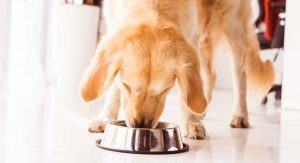 Grain free diets for dogs have recently become featured in the news. Between January 1, 2014 and April 30, 2019, the FDA received 524 reports of canine dilated cardiomyopathy (DCM). The total number of pets affected is much greater than 524, due to many households having more than one pet. The FDA is investigating a potential dietary link between DCM and dogs eating certain grain-free dog foods. The foods of concern are those containing legumes such as peas or lentils, other legume seeds, or potatoes listed as primary ingredients. The FDA began investigating this matter after it received reports of DCM in dogs that had been eating these diets for a period of months to years. DCM itself is not considered rare in dogs, but the reports are unusual because the disease occurred in breeds of dogs that are not typically prone to the disease.
Grain free diets for dogs have recently become featured in the news. Between January 1, 2014 and April 30, 2019, the FDA received 524 reports of canine dilated cardiomyopathy (DCM). The total number of pets affected is much greater than 524, due to many households having more than one pet. The FDA is investigating a potential dietary link between DCM and dogs eating certain grain-free dog foods. The foods of concern are those containing legumes such as peas or lentils, other legume seeds, or potatoes listed as primary ingredients. The FDA began investigating this matter after it received reports of DCM in dogs that had been eating these diets for a period of months to years. DCM itself is not considered rare in dogs, but the reports are unusual because the disease occurred in breeds of dogs that are not typically prone to the disease.
Canine Heart Disease or Dilated Cardiomyopathy (DCM) is a type of canine heart disease that affects the heart muscle. The hearts of dogs with DCM have a decreased ability to pump blood, which often results in congestive heart failure. Some breeds, especially large and giant breeds, have a predisposition to DCM. These breeds include Doberman Pinschers, Great Danes, Newfoundlands, Irish Wolfhounds, and Saint Bernards. While DCM is less common in medium and small breeds, English and American Cocker Spaniels are also predisposed to this condition.
The reports submitted to the FDA of affected pets span a wide range of breeds, including many without a known genetic predisposition. When early reports from the veterinary cardiology community indicated that recently, atypical cases occurred in breeds like Golden Retrievers, Labrador Retrievers, Whippets, Bulldogs, and Shih Tzus all consistently ate grain alternatives in their diets, the FDA took notice.
In the FDA’s July 2019 update on diet and canine heart disease, they examined labels of dog food products reported in DCM cases to determine whether the foods were “grain-free” (defined as no corn, soy, wheat, rice, barley, or other grains), and whether the foods contained peas, lentils, chickpeas, beans, or potatoes (including sweet potatoes). Their report states that more than 90 percent of foods reported in DCM cases were grain-free, 93 percent of reported foods contained peas and/or lentils, and 42 percent contained potatoes/sweet potatoes.
At this point in time, there is no direct and proven link between DCM and grain-free diets, but dog owners should be aware and conscious of the warning issued by the FDA.
The FDA’s July 2019 update includes the names of dog food brands that were named ten or more times in reports submitted until April 30, 2019. Most reports were for dry dog food, but raw, semi-moist, and wet foods were all represented. These foods include Acana, Zignature, Taste of the Wild, 4Health, Earthborn Holistic, Blue Buffalo, Nature’s Domain, Fromm, Merrick, California Natural, Natural Balance, Orijen, Nature’s Variety, Nutrisource, Nutro, and Rachael Ray Nutrish.
In the December 1 edition of the Journal of the American Veterinary Medical Association, Lisa M. Freeman, DVM, Ph.D., DACVN prompts that the issue is not just grain-free diets. She also suspects the “BEG” diets to be culprits. These include boutique companies, foods containing exotic ingredients, and grain-free diets. “The apparent link between BEG diets and DCM may be due to ingredients used to replace grains in grain-free diets, such as lentils or chickpeas, but also may be due to other common ingredients commonly found in BEG diets, such as exotic meats, vegetables, and fruits,” Freeman wrote. Freeman emphasizes that although there appears to be an association between DCM and BEG diets, the relationship has not yet been proven, but still practice caution in feeding BEG diets.
As a general rule of thumb, the best thing you can do for your dog is to contact your veterinarian. Feel free to contact Dr. Olsen at 618-656-5868 with any questions.
Pet Gift Guide For The Holidays – 2019
 No matter how a pet comes into your life, there is a bond that you share with it. Pets can be quirky, happy-go-lucky, weird, smart, grouchy, or even lazy. Whatever their personality the don’t ask for much but maybe a little attention, love and care. With the holidays right around the corner, it is a tradition that I highlight some of the unique pet safe toys, treats and equipment that I have found throughout the year. By no means will this list be all-inclusive, but if “mans-best-friend” is still on your shopping list, this may help give you some ideas that will please then.
No matter how a pet comes into your life, there is a bond that you share with it. Pets can be quirky, happy-go-lucky, weird, smart, grouchy, or even lazy. Whatever their personality the don’t ask for much but maybe a little attention, love and care. With the holidays right around the corner, it is a tradition that I highlight some of the unique pet safe toys, treats and equipment that I have found throughout the year. By no means will this list be all-inclusive, but if “mans-best-friend” is still on your shopping list, this may help give you some ideas that will please then.
Bike Tow Leash – From Amazon, this leash attaches to the left side of most bikes or wheelchairs. It allows you to walk or run your dog without worrying that the dog or the leash will become entangled in your bike wheels.
Mudbuster Paw Cleaner – Also available on Amazon, this cup with a silicone top and tendrils inside allow you to wash off your dog’s paws one at a time quickly and without a mess.
Bacon Bubble Blower – Sorry to burst your bubble, but this toy will keep your dog popping with excitement as it chases these 100% non toxic, tear free bubbles that are made from a bubble blower that is also available on Amazon.
Bark Snoot Scoops – From Bark Shop, this ice cream treat is the perfect way to keep cool next summer especially after laying out by the pool. Its’ ingredients include nonfat dried whole milk, dried cane molasses, dried banana and blueberries, goat’s milk, vanilla and gelatin.
Splatter Pet Sweatshirt – These sweatshirts are a trendy sweater that supports a good cause. The company that makes these-Found My Animal-gives back to shelter dogs in need and promotes adoption with every purchase.
Furbo Dog Camera – If you have a need to check in with your pet while you are away, this camera is highly recommended and has some fun features, like 2-way audio and the ability to dispense treats.
Wild One Carrier – Not only is this pet carrier stylish, it is waterproof, padded for your comfort, breathable, and has a unique cut out so your pet can see what is going on.
Pet Teepee Tent – This pet oasis definitely won’t be an eyesore in your home. Plus, it is comfortable, machine-washable, and the price won’t break the bank. It is made by Huts and Bay.
NOW FOR THE CAT LOVERS!
Bergen Turbo Scratcher Cat Toy This toy stands out as a clear winner thanks to its combination of durable scratch pad, entertaining ball track and irresistible catnip.
Petstages Tower of Tracks Available on Amazon, this track toy combines three levels of circular tracks, each with their own brightly colored ball. It is intended to stimulate your cat’s instincts and encourage them to play. The balls are fixed in place thanks to closed tracks. It encourages the cats to play independently, but also provides options for you to play with your cat. Multiple cats can also play.
Hexburg Mouse Cat Toy It is if your cat loves to pounce and chase. With realistic and random movements, your cat will have hours of fun with this mouse. It is able to navigate around furniture, can flip back onto its feet when overturned, but is suitable for hard wood floors only.
Friends Forever Cat Laser Toy It is packed full of features that means that your cat will be kept entertained and exercised through healthy play. The eye-catching diamond shaped pointer on the top of the toy is designed to attract your cat by rotating to cast a laser in a range of unpredictable directions.
From all of us here at the Olsen Veterinary Clinic, we would like to wish each and everyone a warm, blessed, and safe holiday season with hope for a very prosperous and healthy 2020. Please don’t hesitate to call us at (618)-656-5868 if you have any concerns or questions.
Why You Should Keep Your Pets Away from the Table This Thanksgiving
 With Thanksgiving approaching, there is no doubt that you pup is going to want to partake in the festivities. However, feeding your pup even a few tasty treats from the table is definitely not the way. More often than not, table food is typically too fatty for a dog’s digestive system and can result in severe stomach upsets. To keep your dog safe and healthy this holiday season, keep the following in mind.
With Thanksgiving approaching, there is no doubt that you pup is going to want to partake in the festivities. However, feeding your pup even a few tasty treats from the table is definitely not the way. More often than not, table food is typically too fatty for a dog’s digestive system and can result in severe stomach upsets. To keep your dog safe and healthy this holiday season, keep the following in mind.
Oily and fatty foods, which are often found on OUR tables, can lead to severe dog health problems such as diarrhea, vomiting, and pancreatitis. Even worse, there are several people foods that can be toxic to dogs. For example, onions or any food prepared with them are unsafe for dogs and should never be given to them. Moreover, dogs that are constantly fed with table scraps have the tendency to become dependent on them. Dogs that eat table scraps may start refusing to eat regular dog food. Feeding your pet with table scraps can also cause them to develop bad behaviors such as begging. If you wish to reward your pet for good behavior, give them treats made for them.
If for some reason you just cannot stop feeding your pet table scraps, follow the following rules:
No junk food! Never feed your dog junk foods such as fries, potato chips, leftover pizza, or candies. Your dog should only get healthy food items like steamed or baked potatoes, plain rice, oatmeal, bits of cooked chicken or turkey, finely chopped or steamed unseasoned veggies and certain fresh fruits.
Moderation is key! If you like giving your dog healthy people food, don’t forget to factor his meals into his daily calorie requirement, then, feed your pooch less of their own dog food so they don’t gain weight. Be sure to balance their diet since your dog still needs their regular food. Just try giving less of it on times when you are feeding him with healthy table scraps.
Watch out for toxic food! Above all, you should avoid foods that have been found to be poisonous to dogs. These include, for example, raisins, onions, chocolate, cooked bones, fruit pits, and walnuts. For a more complete list, check it out here.
If you wish to feed your dog human food, a great way to do it is to cook a recipe specifically designed for dogs. These often include scraps that pose no harm to your dog, including rice, cooked eggs, carrots, cheese, peanut butter, berries, chicken, green beans, seedless watermelon, and bananas.
As always, feel free to reach out to Olsen Veterinary Clinic with any questions at 618-656-5868.
Dr. Olsen’s Breed Spotlight: The Peruvian Inca Orchid
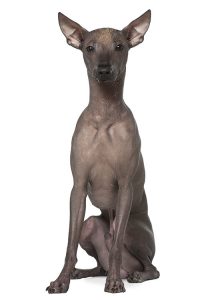 The Peruvian Inca Orchid is not a flower, but a hairless sighthound that developed in Peru. The breed can be hairless or coated and can be found in a range of sizes. These dogs are good hunters and do well in agility. In the hairless variety, the skin can be of any color. The coated variety features all colors as well including black, brown, pink, tan, and white. On a sunny day, Peruvian Inca Orchids require sunscreen because of their exposed skin.
The Peruvian Inca Orchid is not a flower, but a hairless sighthound that developed in Peru. The breed can be hairless or coated and can be found in a range of sizes. These dogs are good hunters and do well in agility. In the hairless variety, the skin can be of any color. The coated variety features all colors as well including black, brown, pink, tan, and white. On a sunny day, Peruvian Inca Orchids require sunscreen because of their exposed skin.
The ancient history of the Peruvian Inca Orchid can be told through pottery and textiles. The breed first appeared in Moche pottery in 750 AD. The Chancay people used the dogs as companions, and certain pottery even depicts them in sweaters. The Chimu considered them good luck and used the dogs’ warmth for the treatment of arthritis and respiratory conditions.
The original hairless dogs were small companion animals, but when Peru was conquered by the Conquistadors, the small dogs were interbred with the dogs of the foreigners and over the years, three distinct sizes developed. In the mountainous regions, the Andean people protected the dogs, but the breed did not fare well in the cities along the coast. There, the hairless dogs were considered diseased and were often exterminated.
In 1966, an American, Jack Walklin, visited Peru and brought eight dogs back to the US. He is believed to be the one to have named the breed the Peruvian Inca Orchid and the breed was established under that name in the US and Europe. In 2001, Peru declared the breed a National Patrimony and the dogs are now protected in Peru.
Peruvian Inca Orchids come in a range of sizes with the smallest standing just short of 10” and the largest topping out at 26”. The distinguishing feature of a Peruvian Inca Orchid is their hairlessness. Their skin can be a solid color or spotted with unpigmented areas. Peruvian Inca Orchids that are coated are in the minority and can occur in the same litter with hairless Peruvian Inca Orchids.
Peruvian Inca Orchids are slim dogs who are very noble and affectionate to those close to them. At the same time, Peruvian Inca Orchids are lively, alert, and can be wary of strangers. Peruvian Inca Orchids make good watch dogs. Peruvian Inca Orchids are loyal and protective of their family but like all dogs should be supervised around children. If you have small pets, the Peruvian Inca Orchid might not be the dog for you as Peruvian Inca Orchids might mistake your small pet as prey.
What To Do If Your Dog Gets Into A Fight With Another Dog
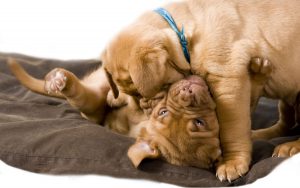 Dogs often wrestle and playfully bite each other. It’s just part of puppy play time. Sometimes, the wrestling turns into a full-blown dogfight. If the fight doesn’t seem to show signs of stopping, it’s important to step in before one of the dogs get hurt.
Dogs often wrestle and playfully bite each other. It’s just part of puppy play time. Sometimes, the wrestling turns into a full-blown dogfight. If the fight doesn’t seem to show signs of stopping, it’s important to step in before one of the dogs get hurt.
Most dogfights only last for a few seconds. It’s important to stay calm and clear headed. Resist the urge to grab your dog by the collar. It might be your first impulse, but when dogs are really fighting, they may whip around and instinctively bite your hand without any past aggression. You are able to tell that it’s a real dogfight when the dog’s bodies are rigid. To stop the fight, make as much noise as possible. You can yell, shriek, stomp your feet, clap your hands, etc. Do whatever you can to attract the dogs’ attention. Similarly, you can use water to get their attention. You can douse the dogs with a hose, bucket of water, etc. (If you are going to a new dog park or unfamiliar place, bring a spray bottle just in case a fight breaks out.) You can also use a barrier such as a large piece of cardboard, plywood, even a big stick to split them up. The large barrier acts as a way to split them up without risking your hands. Lastly, you can throw a blanket over the dogs. Some dogs will stop fighting when they can’t see each other anymore.
It’s important to know when you should step in. Scuffles between dogs last only a few seconds and can appear worse than they actually are. Fights involving fighting breeds should be stopped as they have trouble reacting to social signals from other dogs. Fights between dogs of two very different sizes or two females in heat will need to be broken up; as well as fights involving dogs who are known to have done physical harm in the past or will not walk away. Under no circumstances should you get between the two dogs. You can grab your dog from behind and grab the top of its hind legs, so it is in a wheelbarrow position. You can then walk backwards circling to one side so the dog will not be able to turn and bite you. After you stop the fight, be sure to separate the dogs and keep them out of each other’s sight. This prevents the chance that the two dogs may start fighting again.
To ensure that fight never happens, observe how your dog interacts with other dogs. Does your dog bark, pounce, and snap at other dogs? Do they play rough normally? If you know how your dog acts normally, you will be able to know when a fight is getting ready to begin. When dogs play, it often sounds a lot like it does when they’re fighting. Dogs will growl, snap their jaws, and bite one another roughly. Instead of listening, watch the dogs’ bodies. If they look loose and relaxed, and they’re wagging their tails, they’re probably just playing. However, if the dogs’ bodies appear stiff and rigid, and their tails are down, they may get ready to fight. If one dog thinks it is play time and the other isn’t seeing it as fun, it is best to separate them to avoid any fighting. To further prevent fighting, don’t encourage competition. Dogs get territorial over food and toys. Some breeds are more apt to defend their rights to beloved possessions while some are more apt at sharing. Be sure to know your dog’s unique personality traits so that they can prevent a battle from happening when another dog comes around. You can put treats, food, and toys away when your dog is having social time with another dogs and feed multiple dogs in separate rooms.
Preventing fights start from when the dogs are young puppies. Teach them to play nicely. Use positive reinforcement to reward good behavior. When your dog bites, growls, or exhibits other violent behavior, separate them from the dog that they are playing with and put them in time out until she calms down. Similarly, make sure that your dog knows to come when they are called. If your dog is good at obeying your call to come, you’ll be able to pull them out of tense situations before a fight may start.
As always, feel free to contact Dr. Olsen at Olsen Veterinary Clinic by calling 618-656-5868.
Dry Drowning: What Is It And How Do I Prevent It For My Dog
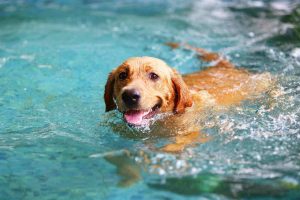 Everyone knows of drowning when a person or a pet is submerged in water and can’t get oxygen. Have you heard of dry drowning? Dry drowning occurs when water is aspirated into the lungs or other parts of the airway. If the water doesn’t make it to the lungs, the vocal cords can begin to spasm making breathing difficult. If water does make its way to the lungs, serious complications and even death may occur. The latter condition is referred to “secondary drowning”, but it’s usually also referred to as dry drowning. Dry drowning is a scary thing as it can ‘happen’ HOURS after exposure to water. It’s something that affects all animals with exposure to water, from humans to dogs.
Everyone knows of drowning when a person or a pet is submerged in water and can’t get oxygen. Have you heard of dry drowning? Dry drowning occurs when water is aspirated into the lungs or other parts of the airway. If the water doesn’t make it to the lungs, the vocal cords can begin to spasm making breathing difficult. If water does make its way to the lungs, serious complications and even death may occur. The latter condition is referred to “secondary drowning”, but it’s usually also referred to as dry drowning. Dry drowning is a scary thing as it can ‘happen’ HOURS after exposure to water. It’s something that affects all animals with exposure to water, from humans to dogs.
How does dry drowning happen? It can be brought on by a dramatic water event or just a typical bath. A dog whose head goes under the bathwater is just as susceptible as a dog who actively jumps into the pool. In a lot of cases, dry drowning doesn’t look like much at all as the condition starts to shape.
Dry drowning is caused by swallowing water. That’s it! For a moment, consider how large your dog’s mouth is and imagine what it feels like when you go underwater unprepared. The natural instinct is to gasp for air, and it is unavoidable. If your dog has the same instinct, your dog could swallow a lot of water in just one gulp.
If water has gotten into your dog’s lungs, it could take hours or in some cases even days for signs to show. The most common symptoms include coughing or hacking, signs of chest pain, difficulty breathing or wheezing, and extreme lethargy. If you suspect your dog may be suffering from dry drowning, take your dog to the vet immediately. Even if your dog doesn’t seem to be in duress, it’s best to have your dog checked out just to be sure.
It’s important to note that dry drowning can happen as a result of swallowing sand as well. A dog who respirates a lot of sand can suffer the same ill effects of secondary water drowning and should be checked out by a vet.
To protect your dog from dry drowning, be sure to monitory your dog closely around water. Even if your dog is a prolific swimmer, you want to keep an eye on your dog to make sure that a swallowing episode doesn’t occur. It only takes one swallow to dry drown. If your dog is around water frequently, invest in a fitted life jacket to ensure that your dog’s head stays above water as much as possible. HERE is an article from the American Kennel Club listing multiple safe options. Even though most dogs can doggie paddle, their arms get tired just like ours do. Lastly, always take “near” drowning seriously. Even though dogs have a natural swim instinct, if you ever have to “rescue” your dog from the water you should watch her closely for several days afterwards to look for signs of secondary drowning.
As always, if you have any questions or wish to make an appointment, contact Dr. Olsen at Olsen Veterinary Clinic or call us at 618-656-5868.
How To Protect Your Pet From The Heat
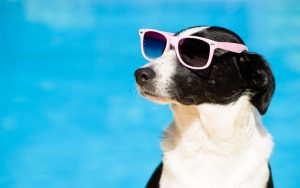 Protecting your pet from the heat is extremely important. As temperatures rise, it becomes more and more uncomfortable to be outside. This is true for your dog as well. During the summer, it is healthier for your dog if you limit outside time, time in dog parks, and exercise to cooler parts of the day, such as morning and evening times. It is not always the temperature as well. The humidity can cause your dog to have difficulty panting. Panting helps your dog cool itself off. Without being able to pant, your dog’s temperature can rise that can lead to heatstroke. If your dog is exhibiting any of the signs of overheating (heavy panting, heavy drooling, trouble breathing, rapid heartbeat, dark or red gums and tongue, dizziness, and weakness, or agitation), be sure to bring your dog to the vet right away. To avoid overheating, there are multiple things that you can do to keep your puppy cool during the hot summer.
Protecting your pet from the heat is extremely important. As temperatures rise, it becomes more and more uncomfortable to be outside. This is true for your dog as well. During the summer, it is healthier for your dog if you limit outside time, time in dog parks, and exercise to cooler parts of the day, such as morning and evening times. It is not always the temperature as well. The humidity can cause your dog to have difficulty panting. Panting helps your dog cool itself off. Without being able to pant, your dog’s temperature can rise that can lead to heatstroke. If your dog is exhibiting any of the signs of overheating (heavy panting, heavy drooling, trouble breathing, rapid heartbeat, dark or red gums and tongue, dizziness, and weakness, or agitation), be sure to bring your dog to the vet right away. To avoid overheating, there are multiple things that you can do to keep your puppy cool during the hot summer.
To begin, make sure to keep your dog groomed, especially if they have long fur. Each breed has different needs. For example, dogs with short, thin coats handle heat better than cold weather and mountain dogs. No dog is immune to heatstroke or paw pad burns, so it’s important to keep your dog groomed. If you get any mats and tangles out of their fur, it will help keep them cool. However, don’t shave or clip their coat until you talk to your vet or groomer. The extra fur that helps your dog stay warm in the winter may also keep it cool in the summer. To keep your dog’s paw pads safe, stick to shaded areas or bring insulation booties to protect your dog’s feet from the hot pavement. To test the heat of the pavement, feel it with the back of your hand. If it is too hot for you, then it is definitely too hot for your dog.
Similarly, be sure to keep your dog’s shots up to date, especially in the summer. The parvovirus spreads in hot weather. During the summer, your dog probably spends more time outside which means that it could come in contact with an animal that has rabies. Summer is also a high season for fleas and mosquitos, both which carry many diseases. By giving your dog medication to prevent these pests, your dog will be safer in the long run.
This should go without saying but leave your pet at home unless your destination is pet friendly. Do not leave your pet in your car. Even with the windows of your car cracked, the temperature inside the car rises rapidly in the summer heat. Similarly, keep your dog’s water supply full. Be sure that there are multiple bowls available for your dog that are always filled with fresh water that is clean. Even if you think that the walk you are going on will be short, be sure to bring clean drinking water and a dish that your dog can easily drink from. If you are worried that your pet is not drinking enough water, add some ice cubes to the bowl. It will make drinking water more appealing to dogs.
When you are spending days outside by a pool or a lake, you can do many things to keep your dog cool while you enjoy the summer sun. You can freeze containers of water so that they will stay cooler for longer. Be sure to keep their water in the shade. You can also provide a small kiddie pool or a sprinkler for your dog to play in. These allow fun places for your dog to cool off and maybe even get some exercise. Similarly, you could put a pet-friendly dig area for your dog in your yard. These can include a sandbox area that your dogs are able to dig in. Dogs often dig a hole to sit in and keep cool. To make an even cooler area, you can spray sand with your cold water. Be sure to make sure that it is located in the shade and not in the sun.
Sometimes, a little extra help is needed to cool your dog. Dog cooling mats and cooling vests are great products. Many work by soaking them in cool water for a long time. If you don’t have access to these, you can soak a towel in cool water and let your dog lie on it. You can also spray your dog’s belly and paws to cool them down. Dogs will cool down more quickly through their belly and paws than water sprayed on their back. Another great DIY to keep your dog cool is to put a pan of ice water in front of the fan to make it more effective for your pup to stay cool.
There are many similar DIYs to keep your pet cool in the summer. Dog-Safe ice cream exists, and you can make it at home. Here is a big list of easy to make ice creams that won’t cost an arm and a leg unlike the gourmet pet store ice-creams. You can also make some frozen treats to put in your dog’s favorite toy. Kong toys come in all shapes and sizes because all dogs love them. They are tough rubber chew toys that are meant to be filled with yummy sticky treats like peanut butter to keep your dog occupied for a while. There are pet-friendly recipes available that are meant to be frozen to keep your dog refreshed while they lick the center. Similar to the Kong treats, you can freeze your dog’s favorite treats in a popsicle mold and fill it with water. It will give your dog a fun treat to keep them cold.
The summer gives many fun opportunities for you and your family. You wouldn’t allow a member of your family to overheat, so don’t let your dog (a furry family member). By following the simple rules of pet care and making some fun treats that your dog will enjoy, you and your dog can have a healthy and cool summer! Make sure to contact our office if you have any questions!
